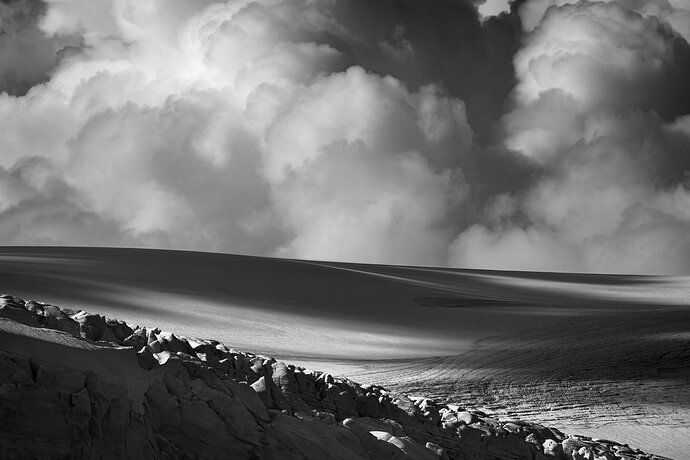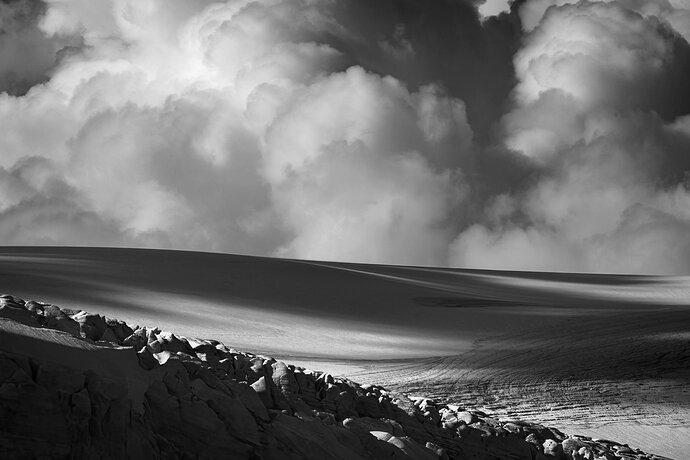Foreground darkened per @Bonnie_Lampley. Thanks for the critique.
Looking across this small Norwegian ice cap, the effect of “orographic uplift” is plainly evident. Just to the west, coastal bays and fjords provide plentiful moisture for the onshore winds to carry up and over the higher terrain. As the air is lifted, it cools, causing water vapor to condense and form billowing clouds which pile up above the ice. It was a really steep climb from sea-level up to this point, perhaps 4000 feet higher, and every minute of the trip was the essence of a mountain experience. However, up here on top, with the rolling ice cap and the dramatic sky, it almost felt like being on the prairie on a turbulent spring day. Well, except for the dramatic icefall immediately below!
Specific Feedback Requested
I was really excited about the prospects for this image when I was pressing the shutter release, and I knew at that moment that this one would be best as a high contrast black and white. But, I have really labored over the processing of this image and have tried three or four different iterations. I think this one best captures the story I want to tell (see above), but I would be very grateful for any feedback on what could be improved.
Technical Details
195 mm; ISO 50; f/13; 1/250th sec.
Post processed in Lightroom (conversion to black and white, some global contrast and tonal adjustments), then local adjustments such as dodging and burning in PS. This is actually a composite of two different processing iterations (both from the same original RAW file): the sky (with higher contrast and more defined cloud details) from one scene, and the ice (lower clarity, darker toning on the foreground ice) from a second scene.
1 Like
Hi Jeff, What a cool B&W image. I think you’ve done a great job with the processing. It feels moody and dramatic at the same time. I don’t know what your other versions were like, but this one really shines. Well done.
Here’s an alternative composition following the same theme, taken from the same location but turned in the opposite direction. These images are potential contributors to a glacier-related project I’m working on, and I doubt I’d want both of these images included since they are similar. Which composition do you think is more powerful?
Very dramatic! I wouldn’t have known this was a glacier - it does look more like a prairie. I’m not sure about the immediate foreground - it feels muddy. Perhaps darkening it more or maybe bringing up the lights for more contrast? Maybe you’ve tried that already.
The other shot is interesting in a different way, being a bit less dramatic. Considering aesthetics only, I prefer the first (high drama) shot, however, if you wanted more emphasis on glacial processes the second one would fit that bill better.
Oh, why not. Another variation on the theme. Opinions sought; feedback still welcomed!
This last one is the best by far in my opinion. But that’s from an artistic point of view. If you’re interested in telling a story about glaciers then the others are better.
Jeff,
I can only imagine the experience you had exploring and photographing these glaciers. Very cool and I’m sure they could all be used in your project.
The clouds and story in your original post are quite dramatic. The clouds (in all of them) are fascinating and I enjoyed your backstory about and including the title, “Weathermaker.”
In all honesty, the first one is hard for me to see and understand that the image is actually a glacier. And what I mean is the foreground ice, looks more like rock, than ice. Also the main body of the glacier looks more like sand to me. I think this is because most of the ice is close to middle grey rather than white. Of course glaciers aren’t pure white and mostly covered with dirt, debris, etc. etc. I’m really curious now if the original color would better represent the glacial environment? I do really like the contrast.
I really like the graphic nature, the shapes and patterns of the glacier in the second and nice balance of light between the ice (light and shadow) and the cool clouds. The curved lines in the second give us a better clue about being a glacier, but again I find tha the middle gray tones just don’t speak “ice” to me. I’m sure it’s just me.
And to the last one - very, very cool and dramatic image. Love the contrast and the dark treatment of the sky above the clouds. Now here, it’s pretty obvious with the white patch of “snow” - and I’m assuming the fresh snow on top of the ice pack? So the snow looks like snow, but it’s not clear to me if the snow is on a slab of granite, on sand, or what.
Admittedly, this is more a response from a glacier novice. And more importantly there’s the main factor that you were there, experiencing not only the physical glacier, but all of that environment.
Terrific images with great drama, great clouds, contrast, etc. All of which are enough to be great images - they just don’t speak “glacier” to me. Hope that makes sense.
Lon
Thanks @Igor_Doncov and @Lon_Overacker for your feedback, as always. This scene is taken from the edge of an ice cap, so the rolling surface is actually flat-lying glacial ice that stretches off for some miles. The grey toned areas are the ice itself, the bright white is a patch of winter snow that hasn’t (yet) melted this year. If it didn’t melt down tot he ice surface, that snow will be buried by this winter’s snow and potentially begin the process of transformation from snow to glacial ice, thus adding ice mass to the ice cap, at least in one little area. All of the grey areas are bare ice where melting has removed all of the previous winter’s snow, and some loss of actual ice mass has occurred this year.
The objective of my project is to spark an emotional response to the unique and highly varied types of landscapes that glaciers great, from the grand scenic “glacier in a landscape” to the macro “landscapes in the glacier”. My objective isn’t to be documentary per se, other than to compel the viewer to consider the beauty that we are losing as our mountain glaciers melt away. Thus, if you find image holds your attention and forces you to reflect on this distant, endangered places/things, it’s not necessary to me that more easily recognize this as a glacier itself. Obviously, looking at this image as a stand-alone, rather than as part of a larger story, renders that connection harder to make. Of course, I welcome your thoughts on my approach, and how well (or not) these glacier images meet my objective.
Thanks so much for taking the time to comment.
Jeff
For what its worth, I have firmly settled on the final composition as my favorite of the three. It’s a good reminder to me to let the image marinate a while after processing rather than solely accepting my emotional response at the moment of capture.



